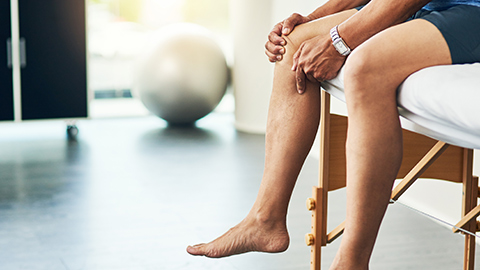
A client training for a big event takes a fall and bruises his thigh. Now he wonders if foam rolling would help, and he has also convinced himself it’s a serious condition: compartment syndrome. He wants advice from his favorite provider. What’s a massage therapist/personal trainer to do?
Reference:
Dubois, B. and J.F. Esculier. “Soft-Tissue Injuries Simply Need PEACE and LOVE.” British Journal of Sports Medicine 54, no. 2 (2020): 72–3. Accessed December 2020. https://doi.org/10.1136/bjsports-2019-101253.
First two days or so:
P: Protection
E: Elevation
A: Avoid anti-inflammatories
C: Compression
E: Education
&
After first two days:
L: Load
O: Optimism
V: Vascularization
E: Exercise


This podcast sponsored by:
0:00:00.0 Speaker 1: Ruth Werner's best-selling book, A Massage Therapist's Guide to Pathology, is a highly regarded, comprehensive resource that sets the standard for pathology education. Written for massage therapy students and practitioners, this groundbreaking resource serves up a comprehensive review of the pathophysiology, signs, symptoms and treatment of more than 500 diseases and disorders. Learn more at booksofdiscovery.com.
0:00:31.8 S1: Oakworks is a proud supporter of ABMP and the massage therapy profession, and is happy to extend a special offer to ABMP podcast listeners. For a limited time, all ABMP podcast listeners receive 25% off Oakworks items with the code ABMPSummit25. Go to massagetables.com and use the code ABMPSummit25 at check out to receive 25% off your Oakworks purchase.
[music]
0:01:10.8 Ruth Werner: Hi, and welcome to "I Have a Client Who... " Pathology Conversations with Ruth Werner, the podcast where I will discuss your real life stories about clients with conditions that are perplexing or confusing. I'm Ruth Warner, author of A Massage Therapist's Guide to Pathology, and I have spent decades studying, writing about, and teaching about where massage therapy intersects with diseases and conditions that might limit our client's health. We almost always have something good to offer, even with our most challenged clients, but we need to figure out a way to do that safely, effectively and within our scope of practice. And sometimes, as we have all learned, that is harder than it looks.
0:01:57.4 RW: Today's "I have a client who" story comes from a massage therapist in Virginia, who did most of my work for me by writing a little script of what happened between her and her client. This massage therapist tells us this story. I have a client who's a runner and I've worked with him in the past. He's currently training for a 50K, including training on trail runs. I'm not currently seeing clients in-person, and the scope of practice for massage in my state and county is pretty much limited to in-person meetings, through our state's definition. But separate from massage, I also have my personal training certification and I offer online sessions in mobility and movement. Again though, just like with massage, my scope does not include the diagnosis or treatment of illness and disease.
0:02:44.8 RW: Here's my correspondence with my client. Client says, "Weird question. I fell Saturday and bruised my quad pretty bad. Should I foam-roll it?" And the response, "You probably know what I'm gonna say already. The answer is: It depends. In studies, foam rolling hasn't shown a significant increase in tissue repair or long-term pain reduction from what I've seen. But if rolling it out feels good, I'm typically on the "Why not?" team. In this case with bruising and pain, I can't see it feeling good. Also, acute inflammation is usually your body's way to work toward recovery, so I kinda like for that to run its course when it's me. I suggest you keep moving it in ways that aren't painful, but don't be pushing it." The client responds, "I like that better than a rest. I need the plague to end so I can get some massage. Nothing feels good right now but resting it. Normally, I'd welcome the chance to be lazy, but I've got my first 50k in two weeks and I'm nervous. I know Google can't give me medical advice either, but last night it convinced me I have compartment syndrome."
0:03:54.7 RW: The massage therapist replies, "I'd really love to recommend that you go see your physical therapist, just to get their opinion and to rule out anything else like DVT. Plus, you'll feel better knowing too. If it's compartment syndrome or something else that's complicated, these things can be addressed successfully with special care that's way outside my scope for sure, especially with this 50k coming up." And the client responds, "Ugh, okay, I'll call the PT." And the massage therapist says, "Thanks, friend. And if you need some names or numbers, you let me know."
0:04:32.5 RW: So which way shall we go down here? We could go down the compartment syndrome route or down the Doctor Google route. I'll tell you what, let's dispense with Dr. Google, 'cause that's sort of irresistible, and then I'll give a little background on compartment syndrome and the version of it that can happen in the thigh. Way back when I first got started in this field in the pre-Google and even the pre-internet Dark Ages, if a person wanted to look up some symptoms, they had very limited options. One of my early references for things like this was the AMA Family Medical Guide, which was a user-friendly resource with lots of algorithms to help you decide if your symptoms meant you needed to see a doctor or not. Now we can go straight to Google and end up worrying ourselves into a frenzy, like this client did. I think this massage therapist did a perfect job of identifying that he was worried and he wanted her expert opinion, but she was unwilling to violate her scope of practice, so she referred him out to his PT, who could give him a better assessment and who could also understand his anxiousness about keeping up with his training for his big event coming up.
0:05:50.1 RW: I think it's likely that lots of massage therapists have had clients come to them with self-diagnosed problems, based off of what they find on Medscape or from the Mayo Clinic or other internet resources. This can put us in the difficult position of saying that we don't think that diagnosis is correct, while also explicitly not diagnosing. This is a situation where it's always best to refer clients to their healthcare team, who have that level of assessment and diagnosis within their scope of practice.
0:06:22.9 RW: Now, let's talk a little bit about compartment syndrome, because this is a fascinating situation. Briefly, compartment syndrome is the name for a series of bad things that happen, when too much fluid accumulates inside a tough, non-stretchy space that is encased by fascia. I'd like to read just a couple of sentences from my book that explains this more clearly than I could just by chatting with you, so here it is. "Two forces operate to maintain fluid balance within tight fascial compartments, especially in the lower leg: Tissue pressure, which is partly determined by the rate and volume of incoming fluid, and perfusion pressure, which describes the ratio of blood in the arteries compared to that in the veins within an enclosed space. When tissue pressure rises above perfusion pressure, then fluid enters the capsule, but the delivery system to move it out again is compromised, and the result is a vicious circle. Fluid pours into the area, but it cannot leave, because exit routes are compressed. Starving and damaged cells release pro-inflammatory chemicals that boost capillary permeability and attract and retain yet more fluid."
0:07:48.3 RW: So as we hear from this description, compartment syndrome most often happens in the lower leg, but it has been seen in other areas as well. And there is a version called meralgia paresthetica, that occurs in the lateral thigh, and I wonder if through his explorations on Google, this client thought that maybe that's what had happened for him. Compartment syndrome can be acute or chronic. Acute compartment syndrome is typically related to a big, immediate trauma like a crushing blow, or an insect sting with a huge inflammatory response, or burns, or some other very serious trauma. But chronic compartment syndrome, which is also called exertional compartment syndrome, there's a hint, is much more common. So this is a situation where work leads to this imbalance in fluid flow, which causes pain and loss of function. It has a predictable onset after a certain level of physical work or exercise, and then the pain becomes too difficult to continue with, and of course, this can really limit an athlete's ability to train, so it's definitely worth getting looked at. However, for this client, the injury he sustained with his fall is unlikely to have led so quickly into chronic compartment syndrome either.
0:09:19.7 RW: Compartment syndrome can lead to some really serious problems, including nerve damage and muscle death, leading to rhabdomyolysis and kidney failure. It's not unheard of for someone with acute compartment syndrome to end up needing an amputation. So based on this conversation, between the client and the therapist, it seems pretty clear he doesn't have compartment syndrome, but she's not in a position to tell him, "Oh, no, your fears are totally ungrounded. It's definitely not compartment syndrome, don't worry about it." But what can she do? Well, within their conversation, the massage therapist made some recommendations about using ice. She likes the PEACE and LOVE protocol for musculoskeletal injuries, which was a new one to me, I will attach it in your show notes. And I'm sure in a future "I Have a Client Who... " episode or maybe a blog post, we'll do a more thorough exploration of the musculoskeletal home treatment acronyms, including RICE, PRICES, POLICE and now PEACE and LOVE.
0:10:22.4 RW: She also made it clear that she can't give medical advice or treat things or diagnose things, but she could recommend that her client do some specific reading or refer them to a PT or another healthcare professional. She shared with me her concerns about communication issues and how to find the most appropriate ways to go forward, and here's what she says. "My biggest question always is how to address without catastrophizing. And are there areas in my response where I tread that line too closely between simply referring out to other resources or health care providers, or providing treatment to a presumed ailment?" In my opinion, in this instance, this practitioner did a great job of holding her boundaries and giving her client, with whom she was friends before she was his massage therapist, excellent advice. She heard his concerns. She did what she could to give him some options to de-escalate his worry and to suggest some places he could get the kind of information that he really needed.
0:11:28.9 RW: The relationship between massage therapists and clients is unique. After all, what other kind of healthcare professional do you spend an hour or more of completely focused time and touch with, other than your dental hygienist? And one of the upshots of that special relationship we have is that our clients will sometimes give us way more authority than we can accept. It can feel flattering and incredibly validating to have our opinions taken so seriously, but I hope you'll agree with me that when it comes to talking to people when they're worried about their health, our role is to point them to medical professionals who are better suited to providing them with the information they need.
0:12:14.9 RW: Hey, everybody, thanks for listening to" I Have a Client Who... " Pathology Conversations with Ruth Werner. Remember, you can send me your "I Have a Client Who... " stories to ihaveaclientwho@ABMP.com. That's ihaveaclientwho, all one word, all lowercase at ABMP.com. I can't wait to see what you send me, and I'll see you next time.
0:12:43.3 S1: Anatomy Trains is excited to announce a new on-demand video course with Tom Myers coming soon, Deeper Ground: Restoration and Vitality for the Female Pelvis. Reach your deeper ground of embodied awareness and strategic confidence with this four-hour tour of the female pelvis, including its key points and unique challenges. Course highlights include hands-on palpation certainty and technique review for the major muscle groups, assessments and techniques for posterior and anterior pelvic floor, psoas complex and diaphragm, common perinatal bio-mechanical issues explained, and much more. Sign up for the Anatomy Trains' newsletter at AnatomyTrains.com to be notified when the course is available.